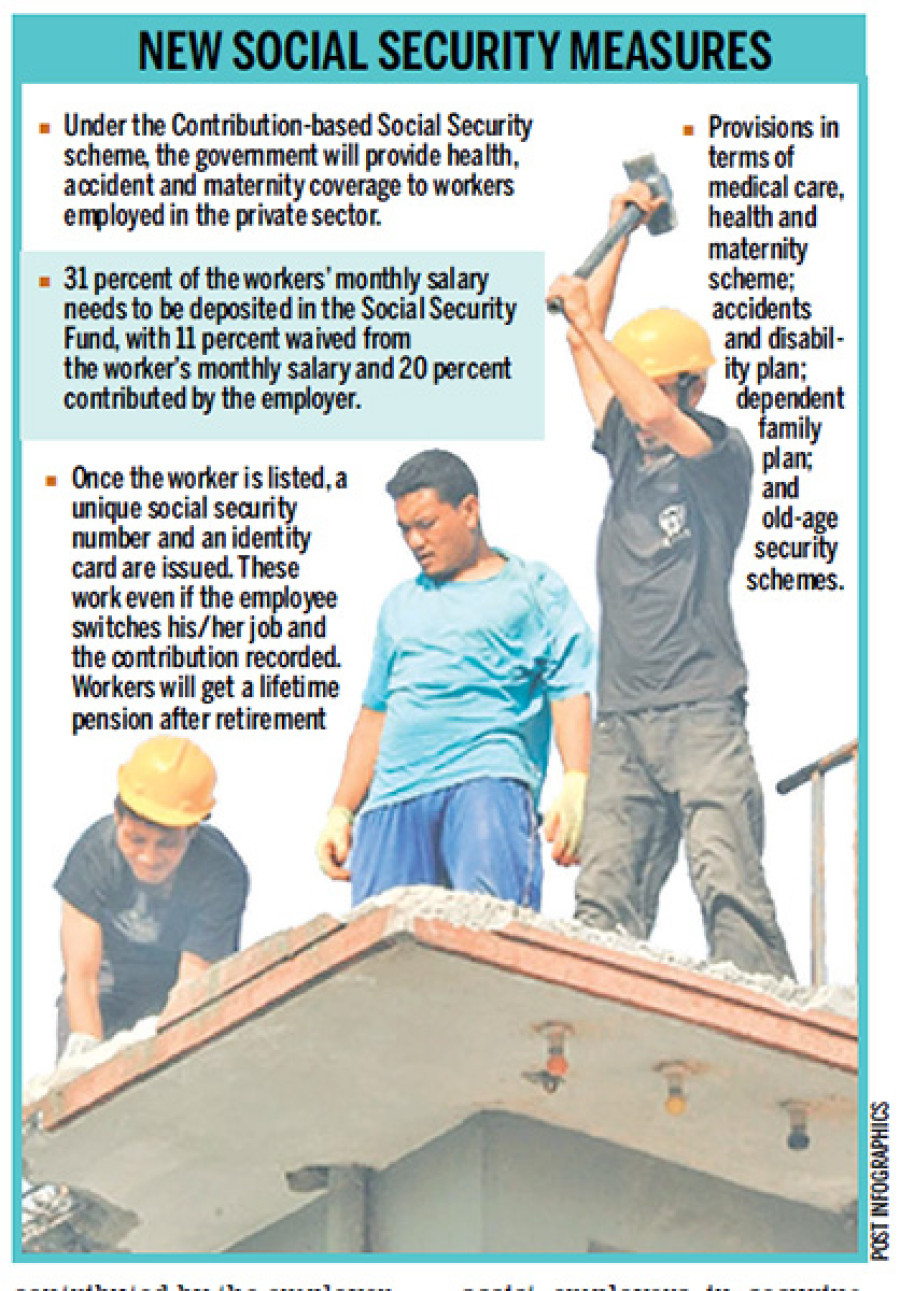Thu, Jan 8, 2026
National
Ambitious social security scheme ready for private sector workers
The government has introduced an ambitious social security scheme to protect and secure employees working in the formal private sector, a historic step for a country where workers’ safety and rights have been an issue of concern.
bookmark
Chandan Kumar Mandal
Published at : November 24, 2018
Updated at : November 24, 2018 15:06
Kathmandu
The government has introduced an ambitious social security scheme to protect and secure employees working in the formal private sector, a historic step for a country where workers’ safety and rights have been an issue of concern.
Under the Contribution-based Social Security scheme, which will be formally implemented from next week, the government will provide health, accident and maternity coverage to workers employed in the private sector.
In the first phase of the scheme, employees from the private sector will be provided with financial security in terms of medical treatment, health protection and maternity scheme; accidents and disability plan; dependent family plan; and old-age security programmes.
The scheme was unveiled on Friday, in Kathmandu, with Mahesh Prasad Dahal, secretary at the Ministry of Labour, Employment and Social Security, announcing that in order to avail of the scheme, 31 percent of the workers’ monthly salary needs to be deposited to the Social Security Fund, with 11 percent waived from the worker’s monthly salary and 20 percent contributed by the employer.
“This is a win-win scheme for all the stakeholders—workers and employers. The scheme will ensure social security of workers as well as assist employers in securing the safety and protection of their workers,” said Secretary Dahal.
“Workers can directly access support from the fund whenever they need it while employers will also not face any hassles while providing financial support to workers in case of tragedies, as they will have a fund to turn to.”
Once the worker is listed, they will get a unique social security number and an identity card. The same number and identity card will work even if the employee switches job and his/her contribution will be recorded with the same social security number. According to the scheme, workers will also get a lifetime pension after retirement.
For accessing the scheme’s medical treatment services and medicine plan—which covers doctor’s fees, hospital charges, various test fees, medicine cost, and travel expenses, among others—the worker must have contributed to the fund for a minimum of six months.
To receive maternity coverage, workers should deposit money for at least 12 months (in the last 18 months), said Shyam Raj Adhikari, executive director at the Social Security Fund, under the Labour Ministry. However, there are no time limits set for accessing the accident and disability security plan, and workers are entitled to accessing the compensation from the first day of contribution.
“In case of workplace accidents and disabilities, financial support will be immediately provided. Also, if the worker dies or is injured en route to the workplace from home, or vice versa, financial support will be provided,” Adhikari added.
The fund will also bear all the expenses of occupational diseases on behalf of the worker, but only if they have contributed to the fund for two continuous years. In case of other accidents other than at the workplace, workers will receive a maximum aid of Rs700,000.
The scheme also ensures similar coverage for family members of the worker, as long as they live, in case of the worker’s death. As per the plan, the worker’s spouse will receive a monthly pension equivalent to 60 percent of their basic salary of the last job for lifetime. Likewise, deceased worker’s children will receive of 40 percent of their parent’s monthly salary as educational support till the age of 18. If the deceased worker does not have any spouse or children, parents of the worker will get 60 percent of their monthly salary as pension.
The scheme, which Prime Minister KP Sharma Oli will formally launch on November 27, on Thursday started registering workers and employers in Kathmandu Valley.
According to Labour Ministry officials, registration for the scheme will begin in Province 3 from December 1; followed by registrations in Province 1 from December 16; in Province 2 from December 30; in Gandaki and Province 5 from January 15; and end with registrations in the Karnali and Sudurpaschim provinces from January 29. Employers should complete the registration within three months of beginning the process.
Most Read from National
Balendra Shah intensifies political engagements, meets Lamichhane, Ghising and others
US adds Nepal to visa bond list, expands pilot programme to 38 countries
Students allege British College misled them on ‘overseas courses’
‘Like a dream’: Labourer from Dalit community secures full MBBS scholarship
Curfew enforced in Birgunj after rival groups defy prohibitory orders
Editor's Picks
E-PAPER | January 08, 2026
×




 9.68°C Kathmandu
9.68°C Kathmandu









%20(1).jpg&w=300&height=200)





